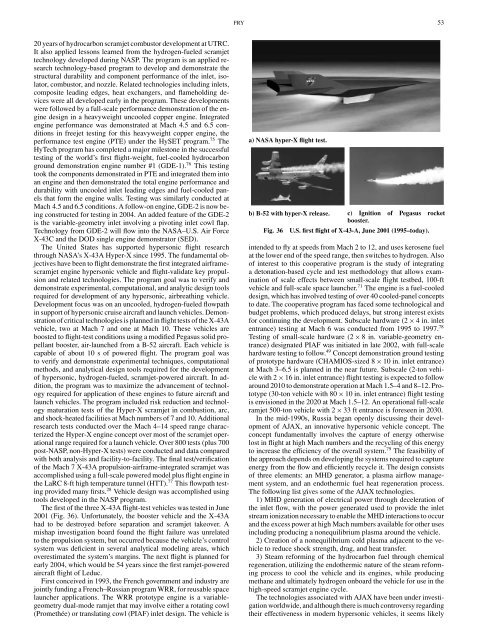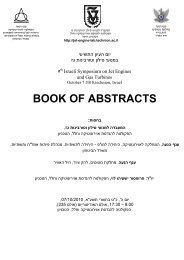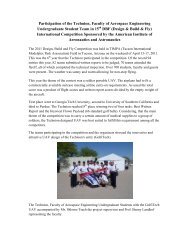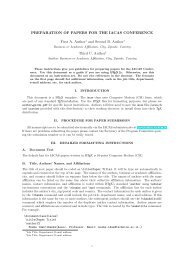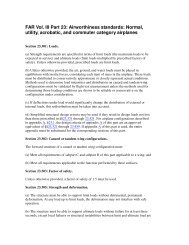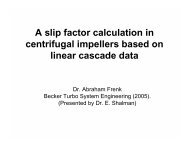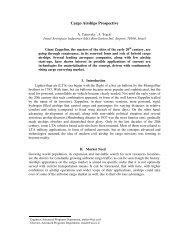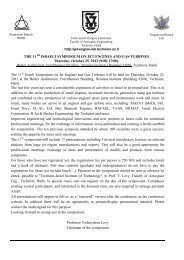A Century of Ramjet Propulsion Technology Evolution - Faculty of ...
A Century of Ramjet Propulsion Technology Evolution - Faculty of ...
A Century of Ramjet Propulsion Technology Evolution - Faculty of ...
Create successful ePaper yourself
Turn your PDF publications into a flip-book with our unique Google optimized e-Paper software.
20 years <strong>of</strong> hydrocarbon scramjet combustor development at UTRC.<br />
It also applied lessons learned from the hydrogen-fueled scramjet<br />
technology developed during NASP. The program is an applied research<br />
technology-based program to develop and demonstrate the<br />
structural durability and component performance <strong>of</strong> the inlet, isolator,<br />
combustor, and nozzle. Related technologies including inlets,<br />
composite leading edges, heat exchangers, and flameholding devices<br />
were all developed early in the program. These developments<br />
were followed by a full-scale performance demonstration <strong>of</strong> the engine<br />
design in a heavyweight uncooled copper engine. Integrated<br />
engine performance was demonstrated at Mach 4.5 and 6.5 conditions<br />
in freejet testing for this heavyweight copper engine, the<br />
performance test engine (PTE) under the HySET program. 75 The<br />
HyTech program has completed a major milestone in the successful<br />
testing <strong>of</strong> the world’s first flight-weight, fuel-cooled hydrocarbon<br />
ground demonstration engine number #1 (GDE-1). 76 This testing<br />
took the components demonstrated in PTE and integrated them into<br />
an engine and then demonstrated the total engine performance and<br />
durability with uncooled inlet leading edges and fuel-cooled panels<br />
that form the engine walls. Testing was similarly conducted at<br />
Mach 4.5 and 6.5 conditions. A follow-on engine, GDE-2 is now being<br />
constructed for testing in 2004. An added feature <strong>of</strong> the GDE-2<br />
is the variable-geometry inlet involving a pivoting inlet cowl flap.<br />
<strong>Technology</strong> from GDE-2 will flow into the NASA–U.S. Air Force<br />
X-43C and the DOD single engine demonstrator (SED).<br />
The United States has supported hypersonic flight research<br />
through NASA’s X-43A Hyper-X since 1995. The fundamental objectives<br />
have been to flight demonstrate the first integrated airframescramjet<br />
engine hypersonic vehicle and flight-validate key propulsion<br />
and related technologies. The program goal was to verify and<br />
demonstrate experimental, computational, and analytic design tools<br />
required for development <strong>of</strong> any hypersonic, airbreathing vehicle.<br />
Development focus was on an uncooled, hydrogen-fueled flowpath<br />
in support <strong>of</strong> hypersonic cruise aircraft and launch vehicles. Demonstration<br />
<strong>of</strong> critical technologies is planned in flight tests <strong>of</strong> the X-43A<br />
vehicle, two at Mach 7 and one at Mach 10. These vehicles are<br />
boosted to flight-test conditions using a modified Pegasus solid propellant<br />
booster, air-launched from a B-52 aircraft. Each vehicle is<br />
capable <strong>of</strong> about 10 s <strong>of</strong> powered flight. The program goal was<br />
to verify and demonstrate experimental techniques, computational<br />
methods, and analytical design tools required for the development<br />
<strong>of</strong> hypersonic, hydrogen-fueled, scramjet-powered aircraft. In addition,<br />
the program was to maximize the advancement <strong>of</strong> technology<br />
required for application <strong>of</strong> these engines to future aircraft and<br />
launch vehicles. The program included risk reduction and technology<br />
maturation tests <strong>of</strong> the Hyper-X scramjet in combustion, arc,<br />
and shock-heated facilities at Mach numbers <strong>of</strong> 7 and 10. Additional<br />
research tests conducted over the Mach 4–14 speed range characterized<br />
the Hyper-X engine concept over most <strong>of</strong> the scramjet operational<br />
range required for a launch vehicle. Over 800 tests (plus 700<br />
post-NASP, non-Hyper-X tests) were conducted and data compared<br />
with both analysis and facility-to-facility. The final test/verification<br />
<strong>of</strong> the Mach 7 X-43A propulsion-airframe-integrated scramjet was<br />
accomplished using a full-scale powered model plus flight engine in<br />
the LaRC 8-ft high temperature tunnel (HTT). 77 This flowpath testing<br />
provided many firsts. 28 Vehicle design was accomplished using<br />
tools developed in the NASP program.<br />
The first <strong>of</strong> the three X-43A flight-test vehicles was tested in June<br />
2001 (Fig. 36). Unfortunately, the booster vehicle and the X-43A<br />
had to be destroyed before separation and scramjet takeover. A<br />
mishap investigation board found the flight failure was unrelated<br />
to the propulsion system, but occurred because the vehicle’s control<br />
system was deficient in several analytical modeling areas, which<br />
overestimated the system’s margins. The next flight is planned for<br />
early 2004, which would be 54 years since the first ramjet-powered<br />
aircraft flight <strong>of</strong> Leduc.<br />
First conceived in 1993, the French government and industry are<br />
jointly funding a French–Russian program WRR, for reusable space<br />
launcher applications. The WRR prototype engine is a variablegeometry<br />
dual-mode ramjet that may involve either a rotating cowl<br />
(Promethée) or translating cowl (PIAF) inlet design. The vehicle is<br />
FRY 53<br />
a) NASA hyper-X flight test.<br />
b) B-52 with hyper-X release. c) Ignition <strong>of</strong> Pegasus rocket<br />
Fig. 36<br />
booster.<br />
U.S. first flight <strong>of</strong> X-43-A, June 2001 (1995–today).<br />
intended to fly at speeds from Mach 2 to 12, and uses kerosene fuel<br />
at the lower end <strong>of</strong> the speed range, then switches to hydrogen. Also<br />
<strong>of</strong> interest to this cooperative program is the study <strong>of</strong> integrating<br />
a detonation-based cycle and test methodology that allows examination<br />
<strong>of</strong> scale effects between small-scale flight testbed, 100-ft<br />
vehicle and full-scale space launcher. 71 The engine is a fuel-cooled<br />
design, which has involved testing <strong>of</strong> over 40 cooled-panel concepts<br />
to date. The cooperative program has faced some technological and<br />
budget problems, which produced delays, but strong interest exists<br />
for continuing the development. Subscale hardware (2 × 4 in. inlet<br />
entrance) testing at Mach 6 was conducted from 1995 to 1997. 78<br />
Testing <strong>of</strong> small-scale hardware (2 × 8 in. variable-geometry entrance)<br />
designated PIAF was initiated in late 2002, with full-scale<br />
hardware testing to follow. 49 Concept demonstration ground testing<br />
<strong>of</strong> prototype hardware (CHAMIOS-sized 8 × 10 in. inlet entrance)<br />
at Mach 3–6.5 is planned in the near future. Subscale (2-ton vehicle<br />
with 2 × 16 in. inlet entrance) flight testing is expected to follow<br />
around 2010 to demonstrate operation at Mach 1.5–4 and 8–12. Prototype<br />
(30-ton vehicle with 80 × 10 in. inlet entrance) flight testing<br />
is envisioned in the 2020 at Mach 1.5–12. An operational full-scale<br />
ramjet 500-ton vehicle with 2 × 33 ft entrance is foreseen in 2030.<br />
In the mid-1990s, Russia began openly discussing their development<br />
<strong>of</strong> AJAX, an innovative hypersonic vehicle concept. The<br />
concept fundamentally involves the capture <strong>of</strong> energy otherwise<br />
lost in flight at high Mach numbers and the recycling <strong>of</strong> this energy<br />
to increase the efficiency <strong>of</strong> the overall system. 79 The feasibility <strong>of</strong><br />
the approach depends on developing the systems required to capture<br />
energy from the flow and efficiently recycle it. The design consists<br />
<strong>of</strong> three elements: an MHD generator, a plasma airflow management<br />
system, and an endothermic fuel heat regeneration process.<br />
The following list gives some <strong>of</strong> the AJAX technologies.<br />
1) MHD generation <strong>of</strong> electrical power through deceleration <strong>of</strong><br />
the inlet flow, with the power generated used to provide the inlet<br />
stream ionization necessary to enable the MHD interactions to occur<br />
and the excess power at high Mach numbers available for other uses<br />
including producing a nonequilibrium plasma around the vehicle.<br />
2) Creation <strong>of</strong> a nonequilibrium cold plasma adjacent to the vehicle<br />
to reduce shock strength, drag, and heat transfer.<br />
3) Steam reforming <strong>of</strong> the hydrocarbon fuel through chemical<br />
regeneration, utilizing the endothermic nature <strong>of</strong> the steam reforming<br />
process to cool the vehicle and its engines, while producing<br />
methane and ultimately hydrogen onboard the vehicle for use in the<br />
high-speed scramjet engine cycle.<br />
The technologies associated with AJAX have been under investigation<br />
worldwide, and although there is much controversy regarding<br />
their effectiveness in modern hypersonic vehicles, it seems likely


